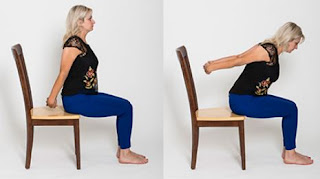Below
is another great post from Richard
Wright. Its focus is on senior citizens and their caregivers using mindfulness
meditation and yoga to improve their mental and physical health while participating
in an activity they are both involved in.
I have practiced mindfulness
meditation for several years now. Every day, after my morning exercises and
stretches, I will meditate. I’ll often meditate again in the early afternoon.
Stretching, along with daily exercise is beneficial for all of us living with
Kennedy’s Disease (SBMA).
Many senior centers and YMCAs offer programs in stretching,
yoga, and mindfulness meditation. For the self-starters, Richard has included
links to sources on the internet that offer podcasts on these topics.
Let me
reemphasize the important side benefit of “participating together.” Living with any debilitating
disorder is difficult for the individual as well as the caregiver. It can also
be a rewarding experience, especially when activities are
done together. Thank you, Richard.
This Is How Yoga and Meditation Can
Transform the Lives of Seniors (And Their Caregivers)
Without
proper stimulation and health-boosting activities, the lives of seniors and
their caregivers can quickly become monotonous. There’s nothing wrong with
having a routine, but it should include activities to get your blood flowing,
improve strength, expand your mind, and relieve stress. You might be wondering
how you’ll have time to achieve all those goals, but the good news is that yoga
and meditation provide all of those things and more. In addition, they are
activities the two of you can enjoy together or alone, which can help foster a
healthy bond.
Yoga Offers Senior-Specific Benefits
When
done safely and properly, yoga provides many wonderful benefits for seniors and
caregivers alike. For starters, it can help strengthen bones to minimize, prevent, or slow
the progression of osteoporosis, as well as keep your weight in check to
prevent it from interfering with your mobility and desire for a more active
lifestyle. Yoga is a low-impact exercise with a focus on slow, fluid movements,
which can help seniors build strength and balance.
There
are benefits for the mind, as well. Most styles of yoga include focused
breathing and meditation, which can help seniors and caregivers keep their mind
clear and sharp. Additionally, this practice can spike the brain's production
of GABA, the chemical that keeps you calm and relaxed. Yoga requires
instruction and guidance to keep you safe, so classes at your local yoga studio
are the best place to start. However, if you’re looking to get a group of
seniors together with a shared interest in yoga, try a senior meetup group.
Meditation Can Stave Off Loneliness
Just
like wrinkles and gray hair come with age, loneliness is common in seniors.
Perhaps loved ones have passed away or children, family members, and friends no
longer live close by. Loneliness has other impacts too. According to Psych
Central, “loneliness is known to activate inflammatory
genes which, in turn, are known to promote a variety of diseases” However, the
study found that mindfulness meditation reduced feelings of loneliness in
seniors via regular class attendance, and even reduced the genes that are
markers for heart disease and inflammation. Meditation is an integral part of
yoga, but it can be practiced on its own as well. There are several beginner podcasts online that will walk you
through a meditation session.
Commit to the Practice
Yoga
and meditation require dedication and consistent practice. There will be some
days when getting to a class isn’t possible, or perhaps you’d just like to be
able to practice at home once you learn the proper technique. To achieve this,
you’ll need to clear out a room to give you enough space to safely and
comfortably practice. It is best to create a dedicatedspace, as you’ll likely grow tired of having to move around
furniture and items every time you want to practice. If need be, move some of
your belongings into storage to free up space. Incorporate soothing sounds,
scents, colors, and lighting for a truly zen experience.
Safety Comes First
Whether
you are practicing yoga, meditation, or both, safety should always be your top
priority. Yoga is appropriate for all ages, but seniors will benefit from gentle classes such as Iyengar,
Viniyoga, and Kripalu. Most yoga studios offer gentle/beginner classes and can
help you adapt the poses using chairs and props. As the caregiver, it is your
job to communicate with the instructor about the
needs and abilities of your senior loved one. This includes disclosing physical
and mental ailments, as well as their mood for the day.
Life
can be difficult at times for both seniors and caregivers. For this very
reason, self-care is crucial. Yoga and meditation combine physical and mental
health benefits for a relaxing activity the two of you can explore together.
Photo Credits:






